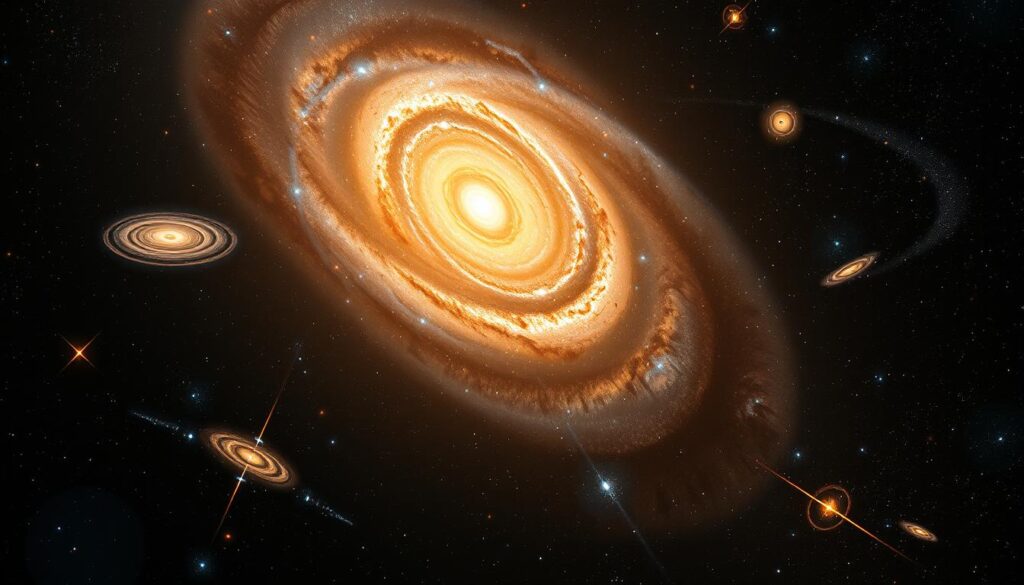The idea of a Self-Similar Universe shows us how everything from tiny to huge is connected. These fractal patterns can be seen in many places, telling us about the world’s basic structure. By looking into cosmic structures, we learn about patterns that are the same everywhere in nature.
This knowledge helps us understand how the universe has evolved. It also makes us think again about the basic rules that control everything. From the smallest atoms to the biggest galaxies, these rules apply.
Introduction to the Self-Similar Universe
Self-similarity is key to understanding our universe’s fabric. This property means objects look the same at different scales. It helps scientists see patterns in various places.
This idea is seen from tiny atomic structures to huge cosmic formations. It shows how things act the same across the universe. This helps those studying space to figure out its complex beauty.
Looking at these repeating patterns helps find connections between different things. Studying self-similarity makes us understand nature better. It opens our eyes to the universe’s wonders.

Understanding Self-Similarity in Nature
Nature’s self-similarity opens up a world for us to understand life’s layout. We often find fractals in nature, showcasing beautiful, repeating patterns. These patterns appear in various biological examples, making nature both stunning and efficient.
The branching of trees and details of leaves show this self-similarity. A branch’s segment looks like the whole tree, and leaf veins show similar patterns. This design lets plants get the most sunlight and spread nutrients effectively.
Mountains and valleys also show nature’s self-similarity through their shapes. These fractal-like features help with water flow and prevent erosion. They help ecosystems thrive and change with time.
Studying these examples helps us see how self-similar patterns are integral to life. They demonstrate the rules of growth and form in living things. Nature masterfully uses repetition and variation to enhance efficiency and resilience.
The Mathematics Behind Self-Similar Structures
Self-similar structures show us the beauty of mathematics, especially through fractal geometry. This field, led by Benoit Mandelbrot, helps us see patterns in the universe. It shows how fractal geometry is used in many sciences, linking complex systems across different sizes.
Fractal Geometry and Cosmic Distribution
Fractal geometry is key for studying cosmic structures. It helps measure repeating patterns at different sizes. This math shows galaxies, clusters, and superclusters are part of a bigger, self-similar structure. Thus, it helps scientists study the universe’s matter, helping understand cosmic structures’ growth.
Scale Symmetry in Physics
Scale symmetry is crucial in physics, especially in cosmology. It means physical laws and shapes stay the same at various sizes. The Poisson-Boltzmann-Emden equation shows this by modeling mass distributions. By understanding scale symmetry, we get why similar patterns appear in different places, showing the universe’s unity.
Physical Evidence of Self-Similarity Across Scales
Self-similarity shows up in different natural wonders, backed by lots of physical proof. Studies of the Earth’s shakes show repeating patterns inside our planet. These patterns are self-similar and range from super small to super big sizes.
The stars and galaxies offer more examples. The way galaxies spread out looks surprisingly similar from various views. This shows that things observed in space and on Earth are connected. Researchers like Valade et al. point out that whether we look at tiny atoms or huge galaxies, patterns repeat.
Looking closely at Earth and the cosmos shows self-similar structures everywhere. By studying these patterns, we learn more about how the universe is connected.
Exploring The Self-Similar Universe: From Microscopic to Cosmic
The idea of self-similarity stretches far, from tiny worlds to vast galaxies. This journey from tiny atoms to vast planets helps us see the big picture. It links atom behavior to how planets form, showing how everything big or small is connected.
Microscopic Patterns: Atomic Structures
Even the smallest atoms follow patterns that mirror the universe’s design. Their structure shows fractal patterns, similar to cosmic designs. These patterns are not just beautiful. They show how the very essence of all matter is connected.
Planetary Scales: From Earth to the Moon
Planets and moons form in ways that remind us of these self-similar patterns. Earth and the Moon, for instance, were shaped by giant impacts and gravity. These events told a story of how both big and small follow a cosmic rule. By looking at planets, we learn about the unity in the universe’s design.
Fractal Patterns in Earth’s Interior
The Earth’s inside is fascinating, with fractal patterns showing its structure and how it moves. Thanks to seismology, we’ve learned a lot about the planet’s layers. These findings help us understand geological activities and Earth’s early days.
Seismic Evidence of Density Variations
Seismic waves are key in studying the Earth’s inside. They change speed as they move through different materials. This shows us the Earth’s inner structure in detail. Scientists see patterns in these changes that suggest a fractal setup deep in the planet.
Implications for Earth’s Formation
The patterns from seismic waves do more than just paint a picture. They help us piece together how Earth was formed. It looks like tectonic shifts and minerals played a big part. By linking small scale patterns to the bigger picture, scientists learn more about our planet’s history.
Universal Structures and Cosmic Evidence
The universe shows us a common structure through cosmic events. Studies show how these findings back up galaxy formation ideas. These patterns are consistent across space and time, showing similar traits in many places.
Dark matter greatly helps us understand these universal designs. It shapes galaxies and orders the cosmos. Dark matter clumps together in a way that mirrors patterns seen on Earth and in space.
These cosmic structures mean more than just how galaxies form. They show us a complex cosmic order through different scales. Researchers studying these structures learn more about our universe’s true nature.
Galactic Structures and their Scaled Relationships
Galactic structures are the universe’s backbone, linked by the cosmic web. This network is key for showing where galaxies lie over vast spaces. It shows the universe’s organized layers and patterns at different levels.
Galaxies form a complex system, not standing alone. Scientists studying them learn how they connect and change over time. They’ve found certain rules in the cosmic web that stay the same, hinting at deep cosmic rules.
Studying these galactic forms and their patterns helps us grasp the universe’s design. With each discovery, we see how all space things are linked together.
Patterns of Persistence in Stellar Objects
Stellar objects show intriguing patterns that connect them to the vast cosmos. We see this in black holes and neutron stars. Their actions match self-similar patterns found across the universe. These celestial events are part of larger trends that help us understand cosmic structures.
The LIGO and Virgo collaborations have made big discoveries. They learned a lot about how black holes and neutron stars merge. These events aren’t just random; they follow a specific order that mirrors stellar patterns. The gravitational waves from these mergers give us a unique look into these dense space objects.
These patterns show that the behavior of stellar objects is linked with the universe’s dynamics. As we find more evidence, we understand more about the universe’s complex design. This research is exciting. It opens doors for future studies and helps us see how stellar patterns affect the cosmos.
Dark Matter and Its Role in the Self-Similar Universe
Dark matter is crucial in the universe’s structure, guiding the creation and growth of cosmic forms. It makes up about 27% of the universe but is unseen, known only by its gravity pull. In a universe that repeats patterns, dark matter acts as the base for galaxies and clusters.
Dark matter and normal matter work together in important ways. While normal matter gathers due to gravity, dark matter creates the gravity hole that lets large structures stick together. This helps make a universe where similar patterns show up in both big galaxy groups and smaller clusters.
Studying dark matter helps us understand how the universe is built. We learn how patterns and processes shape the universe’s development, showing dark matter’s key role. Its gravity doesn’t just arrange galaxies; it also forms the huge empty spaces between them.
Modern Implications and Future Direction in Research
The study of cosmic self-similarity is very important for modern research. It shows how patterns in the universe match up across different scales. As scientists study these patterns, they learn more about how the universe works.
Future research aims to use advanced tools like high-res telescopes and complex computer models. These tools help scientists look closer at how cosmic structures work together. They hope to learn more about dark matter and how the universe has changed over time.
There’s a lot of interest in what this means for physics theories. This could change how we see the universe and lead to new discoveries. Simulations are crucial for guessing how cosmic stuff will behave in the future.
Scientists from different fields need to work together to solve big questions about the universe. Understanding cosmic self-similarity better could change what we know about reality. The world of research is on the brink of big changes, making this a very exciting area to explore.
Conclusion
As we delve into the world of self-similar patterns, it’s clear they are found everywhere. From tiny atoms to vast galaxies, these patterns show a connection that links all of existence. This isn’t just for scientists to ponder; it changes how we see the universe.
Studying self-similarity opens up new ways of understanding the universe. It suggests that the complex things we see might actually come from simple, repeating designs. Wrapping up, we see that learning more about these patterns can make the universe’s workings clearer to us.
The idea of a self-similar universe is both a fascinating part of science and a prompt to keep exploring. By digging deeper into this field, we could uncover more about the universe’s fundamental patterns. This journey promises to reveal the universe’s beauty in even greater detail.



